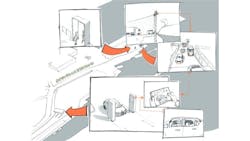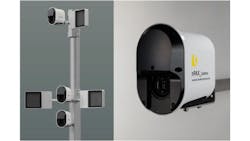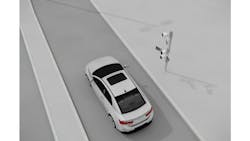Ferry Operators Count on NIR Cameras, AI, for Accurate Passenger Tallies
What you will learn
- Understand how the Adigo nPax AI vision system uses NIR lighting and cameras, and in-house AI software to accurately count passengers inside vehicles, even under challenging conditions, including tinted windows, poor lighting, and adverse weather conditions
- Learn about the system’s cost-optimization strategies, including reducing camera count and infrastructure requirements, to make the technology accessible for both large and small ferry companies.
- Explore the privacy and data protection measures that ensure compliance with strict European regulations, including local on-site processing and immediate deletion of sensitive image data.
Adigo Mechatronics (Ski, Norway) has developed an automated system that uses near infrared (NIR) cameras and LEDS as well as AI algorithms to count passengers as they board a ferry. The system, known as Adigo nPax, has been operating on Norway’s Arsvågen-Mortavika ferry route for more than a year.
In Norway, use of ferries as public transportation is a major part of life. According to Poidata.io, a company that collects, analyzes, and delivers business data globally, there were some 397 ferry services operating in Norway as of August 2025. And, according to the Norwegian government’s Statistics Norway website, some 2.068 million passengers generating more than NOK 123 million (a little over $12 million) used boat transportation – either ferries or ocean-going cruise ships, in the first quarter of 2025.
Ferry operators are required by Norwegian law and International Maritime regulations to calculate and maintain accurate passenger counts. This is a safety requirement; the ferry captain must, among other responsibilities, provide enough safety equipment for everyone on board the boat.
Challenges Counting Fast Moving Cars and People
In the past, passenger counts were conducted when passengers purchased tickets; they would buy them onsite and crewmembers would individually count passengers as they boarded the ferry. However, when the ticket purchasing process became automated and the boarding process free flow—that is, people and vehicles boarding the ferry without having to move through lines and turnstiles— it became necessary for human employees to manually count passengers in every vehicle being driven onto a ferry.
However, people in vehicles move quickly, making the counting process difficult and error prone. Indeed, Norwegian maritime authorities, suspecting that the counts were chronically inaccurate, investigated, verified that the counts were, in fact, chronically off and gave the ultimatum for the ferry operators to fix the problem or face corrective action, says Andre Ødegårdstuen, product manager at Adigo Mechatronics.
Then the COVID epidemic hit, and the emphasis on automation solutions to minimize human contact and interaction became paramount. In fact, four of the largest ferry companies in Norway agreed to sponsor the development of an automated passenger counting system, Ødegårdstuen says.
Developing and Building an AI-Powered Vision System to Count Ferry Passengers
The Adigo nPax system is designed especially for counting people inside vehicles, Ødegårdstuen says. Initially, the system consisted of five NIR cameras, with two cameras placed on a pole, set at different heights, on either side of the roadway through which all vehicles pass to board the ferry. The fifth camera was positioned higher than the others—about 2 and a half to three meters high—on one of the poles so as to scan larger vehicles such as RVs. LED lights operating in NIR wavelengths are also mounted on the poles near the cameras.
To cut the cost of the system, the team subsequently reduced the system to three NIR cameras mounted on one pole. Currently, the components to the system are as follows:
- Three IDS Imaging Development Systems GmbH (Obsersulm, Germany) UI-5240CP Rev.2.2 NIR cameras equipped with Teledyne e2v EV76C560 (Chelmsford,UK) 1.3 MPixel resolution CMOS sensors and Edmund Optics (Barrington, NJ, USA) Techspec C-series lenses.
- Three LED lights—custom configured and integrated for the system by the Adigo Mechatronics team—that operate in NIR wavelengths, mounted near the cameras on the pole.
- An NVIDIA (Santa Clara, CA, USA) Jetson AGX computer located in the on-site office of the company selling the ferry tickets.
Related: From Clipboards to Cameras: Hertz Deploys AI Inspection System for Rental Vehicles
Why NIR Cameras and Lights?
A major challenge was the system's ability to conduct an accurate scan of the inside of some vehicles, because of such issues as heavy window tinting, child seat covers, and weather conditions. Near Infrared (NIR) lighting and cameras are especially useful in challenging lighting conditions, which is often the case when operating outdoors in Norway. In addition, NIR cameras can more easily detect and capture clear images through obstructive materials such as window tinting. However, if the system goes down or has difficulty with a vehicle scan, the system alerts the ferry crew so they can follow up in person, Ødegårdstuen says.
Related: Innovation in LED Lighting Improves Image Quality for Objects In Motion
How the AI Vision Passenger Counting System Works
The cameras capture images from each vehicle and transmit them, via ethernet, to the computer, which is loaded with AI software developed and written in-house by Adigo. The software analyzes and processes the images, provides an accurate passenger count from each vehicle, then immediately sends that information to the ferry’s passenger logging system via 4G wireless network.
“There is no preprocessing on the camera, as the AI works best with the raw data,” Ødegårdstuen explains. “The data transmission from the camera is via GigE. There are multiple tasks being handled by different machine learning models, such as detecting the presence of a vehicle in the lane, determining the vehicle type, detecting passengers and an aggregate model that collects info from other models to give the final output. We do not use any conventional computer vision, as machine learning approaches are in practice always more robust given a certain scale.”
The cameras also read license plates and classify the type of vehicle passing through the inspection station. The system does this as part of the ticketing and boarding process, and OCR technology is utilized for this purpose, Ødegårdstuen says.
The cameras, Ødegårdstuen says, operate at approximately a 45 fps frame rate and half-millisecond exposure time.
Ødegårdstuen also notes that the image data the system collects is sensitive information, and Europe has strict regulations about how this kind of information is used and stored. Therefore, all data processing is done locally, on-site, with no external transmission or storage of that data outside the counting system process.
“We have to restrict where we store that information, so we try to minimize the spread of those images,” he says. “We process them locally and then we delete them. In some rare cases, when we see that the system is uncertain, we can take some of the images and annotate them in order to improve the machine learning algorithms.”
Overcoming Challenges for the AI Vision System
One challenge was placement of the system. Seawater and salt air can cause issues with hardware and infrastructure, therfore, the system had to be located onshore, away from the dock and the ferry, Ødegårdstuen says.
The prototype system utilized five cameras mounted on poles on either side of the boarding lane(s). This, however, is cost prohibitive for smaller ferry companies, says Ødegårdstuen, because hardware, especially cameras, is expensive not only to purchase but to set up and operate.
“To use it, you have to have (ethernet) cables crossing the road, so you either have to dig or you have to erect some sort of bridge above and that costs the ferry companies a lot of money. So to reduce the total cost of installing the passenger counter system, we’ve tried to optimize it so it will operate effectively with fewer cameras installed on only one side of the road.”
Another challenge was the initial reluctance of crews to embrace the system, Ødegårdstuen says.
“In the beginning, we got some resistance from the crews because they were worried that we were automating their jobs away,” he says. “This is a legitimate concern—they were right to worry about that—but now that we have the system in place, they see that there are other things they can do that are more rewarding, and less of a hassle, than to stay outside in the Norwegian winter and count people.”
What is the Future of the AI Vision Counting System?
The system, while still a work in progress, has proven its usefulness. Ødegårdstuen says. Indeed, the Adigo team has found that it is not only significantly faster than manual counting but has achieved a 98% accuracy rate in identifying and counting passengers.
Future plans call for several nPax systems to be installed on several new ferry routes in Norway as early as the end of this year. Negotiations with ferry companies in other European countries is also underway, Ødegårdstuen says.
About the Author
Jim Tatum
Senior Editor
VSD Senior Editor Jim Tatum has more than 25 years experience in print and digital journalism, covering business/industry/economic development issues, regional and local government/regulatory issues, and more. In 2019, he transitioned from newspapers to business media full time, joining VSD in 2023.




